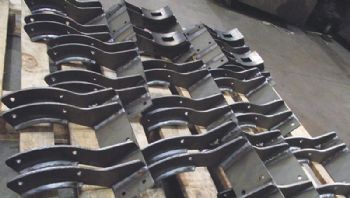
One of the UK’s largest sheet-metal sub-contractors says the Project Nesting function in Radan’s sheet-metal CAD/CAM software (
www.radan.com) is essential for keeping the company competitive.
Moreover, John Haworth — the managing director of Leyland-based Norlec — says it is also a key aspect of the company’s manufacturing flexibility.
“Customers want shorter lead times and smaller batch quantities, so our days of big production runs and nesting the same components on one full sheet are long gone, but the ‘intelligent’ nesting in Radan means we can nest different components from a variety of customers on one sheet.”
Norlec serves a large number of industrial sectors, including yellow goods, heating, shopfitting and electrical switchgear.
Components and finished products vary in size and complexity, ranging from simple brackets, radiator covers and telephone housings to welded assemblies such as engine housings for trains and fabricated assemblies for machines and off-road vehicles.
“It’s so easy with Radan’s Project Nesting to fit small parts onto sheets of much larger components, which means we’re getting more than 80% sheet utilisation instead of the 60-70% we were getting before; and with steel prices rising, maximising sheet utilisation is an important consideration.
“The more efficient we are with steel usage, the better — because we pass that cost saving on to customers, making us more competitive.”
Norlec, which has 50,000ft
2 premises, has recently added to its array of laser cutters, punch presses and press brakes with the installation of a Trumpf 3030 4kW fibre laser and automatic sheet stacker; this can accommodate 33 tonnes of steel for unmanned operation overnight and at weekends (it has 11 pallets, each of which can carry three tonnes of steel).
“The system also removes the parts, once they’ve been cut, and puts them back in the storage trays,” says Mr Haworth, adding that he bought the fibre laser because it cuts thinner-gauge material faster than ‘conventional’ lasers.
“While most of our material is 5mm or less, the fibre laser can cut steel up to 25mm thick — plus copper and brass, which previously we had to punch.
“We have also installed a nitrogen generator, because cutting with this gas improves the painting process further along the production line; and because Radan drives all our CNC machines, we had Radan engineers compile the post-processor for the new laser.
Moreover, having Radan post-processors for all our machines is ideal, as it means we can simply send code to a punch press or a laser.”
He says that overall, Radan helps Norlec overcome its biggest challenge — minimising the time taken from a product being ordered to completing manufacture and shipping it out to the customer.
“From receiving an order, we can process it and have it in work within a few hours. Without Radan, it would take several days — particularly with complex parts.”
Norlec’s technical support engineer, Dave Sharratt, says: “We use Radan’s unfolding method to produce our own flat blank (referred to as a Radan symbol), which is then saved within the Radan system, along with all the symbols we need for current or future jobs.
“We look ahead to see what jobs are coming up, and then put all the parts into the project. It doesn’t matter what type of steel or what gauge it is, because Project Nesting separates it all out.
“We then set the project running and leave the nesting software to automatically put all the symbols into an appropriate nest, taking into account the shape, material and gauge.
“We also use Radan’s process management module — e2i — to control routing throughout the factory, with all the instructions required to make a part managed by it.”